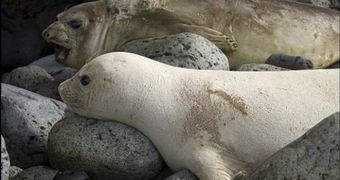A new scientific paper, recently published in the journal Polar Biology, reveals details of a very rare, white elephant seal, which has been caught on camera on the freezing beaches of the sub-Antarctic region. Sporting the usual brown-colored eyes, the animal has an entirely white fur, a trait that is very uncommon among members of the true seal species. Conversely, eared seals, a group that includes such species as sea lions and fur seals, have a higher incidence of white-pigmented individuals, but the former group does not. All other traits of the newly discovered animal are in tune with those expected from a member of its species.
“It's quite something in a species which is well-known. To our knowledge, we're the first to provide detailed evidence of such an animal anywhere,” the BBC News quotes Professor Ryan Reisinger, from the University of Pretoria, in South Africa. He added that the weird animal was leucistic, rather than albino. “This is the first confirmed case of leucism in the species,” he shared. The animal was found on Marion Island, which, together with the Prince Edward Island, are South African territories located in the central part of the Indian Ocean, about halfway between Africa and Antarctica.
Reisinger explained that the difference between leucism and albinism was fairly important. While the latter condition refers to a complete lack of pigment in their eyes, skin and/or hair, the former is characterized by the fact that the animals suffering from it have very little pigment, which makes them look completely white, or cream-colored. As opposed to albinism, in leucism the eyes retain the prevalent color that the species as a whole has, while even the nails and eyebrows turn white.
The seal was first discovered in 2008, but, during the first sighting, the research team were unable to get close enough to confirm the leucism diagnostic. Sometime later, they saw the rare animal again, but this time they managed to observe it in closer detail, tag it, and even get a skin biopsy from it. Reisinger told that it was nearly impossible to say exactly how beautiful the rare animal was. “We can't put it in terms of one in a million, or one in a hundred thousand,” he said. However, in their numerous years of observations and tagging, the experts have never seen a white true seal before.

 14 DAY TRIAL //
14 DAY TRIAL //